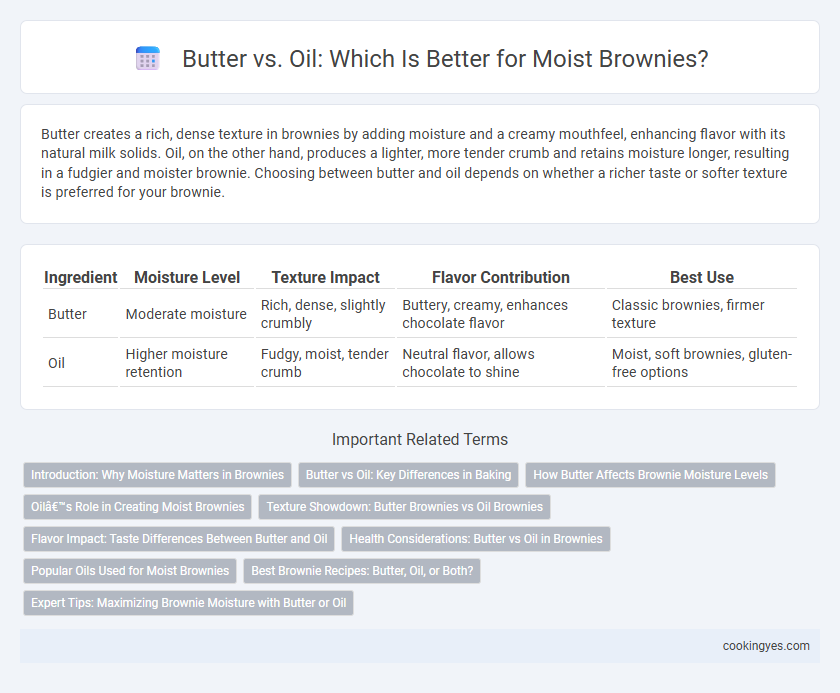Butter creates a rich, dense texture in brownies by adding moisture and a creamy mouthfeel, enhancing flavor with its natural milk solids. Oil, on the other hand, produces a lighter, more tender crumb and retains moisture longer, resulting in a fudgier and moister brownie. Choosing between butter and oil depends on whether a richer taste or softer texture is preferred for your brownie.
Table of Comparison
| Ingredient | Moisture Level | Texture Impact | Flavor Contribution | Best Use |
|---|---|---|---|---|
| Butter | Moderate moisture | Rich, dense, slightly crumbly | Buttery, creamy, enhances chocolate flavor | Classic brownies, firmer texture |
| Oil | Higher moisture retention | Fudgy, moist, tender crumb | Neutral flavor, allows chocolate to shine | Moist, soft brownies, gluten-free options |
Introduction: Why Moisture Matters in Brownies
Moisture plays a crucial role in the texture and overall enjoyment of brownies, impacting their density and mouthfeel. Butter contributes rich flavor and a tender crumb by adding water content and fat, while oil provides a smoother, more uniformly moist consistency due to its 100% fat composition. Selecting between butter and oil directly influences the balance of moistness and richness, essential for achieving the ideal brownie texture.
Butter vs Oil: Key Differences in Baking
Butter contributes a rich flavor and a tender crumb to brownies thanks to its water content and milk solids, which create steam and help with leavening. Oil, being 100% fat, yields a moister and denser brownie by coating flour proteins more thoroughly, preventing gluten formation. Choosing butter results in a fluffier texture with a buttery taste, while oil produces fudgier, more intensely moist brownies.
How Butter Affects Brownie Moisture Levels
Butter enhances brownie moisture levels by contributing a rich, creamy texture due to its water and fat content, which helps retain moisture during baking. The milk solids in butter promote a tender crumb, leading to a fudgier consistency compared to oil-based brownies. Butter's melting behavior also influences the final moisture retention, creating a moist and flavorful brownie.
Oil’s Role in Creating Moist Brownies
Oil plays a crucial role in creating moist brownies by coating flour proteins more effectively than butter, which limits gluten formation and results in a tender texture. Its liquid state at room temperature allows the fat to disperse evenly throughout the batter, maintaining moisture and preventing dryness during baking. Compared to butter, oil enhances the fudgy consistency and extends the brownie's shelf life by retaining moisture for longer periods.
Texture Showdown: Butter Brownies vs Oil Brownies
Butter brownies create a rich, dense texture with a slightly chewy crust due to the creaming of butter and sugar, which traps air for lift. Oil brownies yield a moist, tender crumb with a fudgier consistency because oil remains liquid at room temperature and coats flour proteins differently. This texture showdown reveals butter brownies excel in flavor depth and structure, while oil brownies prioritize moistness and softness for a melt-in-your-mouth experience.
Flavor Impact: Taste Differences Between Butter and Oil
Butter imbues brownies with a rich, creamy flavor and a slightly caramelized undertone, enhancing the overall taste complexity. Oil, on the other hand, contributes a neutral profile that allows other ingredients like cocoa and vanilla to stand out more prominently. Choosing butter results in a more indulgent, buttery taste, while oil creates a lighter, more straightforward chocolate experience.
Health Considerations: Butter vs Oil in Brownies
Butter provides richer flavor and contains saturated fats and cholesterol, which may impact heart health negatively if consumed in excess. Oil, especially vegetable or canola oil, offers healthier unsaturated fats that can support cardiovascular health while maintaining brownie moisture. Choosing oil over butter can reduce saturated fat intake, contributing to a healthier brownie option without sacrificing texture.
Popular Oils Used for Moist Brownies
Using oils like canola, vegetable, and coconut oil in brownie recipes enhances moisture retention and creates a tender crumb texture. Coconut oil contributes a subtle richness and slight coconut flavor, while canola and vegetable oils offer neutral taste profiles that allow chocolate flavors to shine. These popular oils outperform butter in moisture preservation due to their liquid state at room temperature, resulting in fudgier and moister brownies.
Best Brownie Recipes: Butter, Oil, or Both?
Butter imparts a rich flavor and tender crumb to brownies, creating a slightly denser texture with a creamy mouthfeel. Oil, especially vegetable or canola, enhances moisture retention and produces fudgier brownies with a lighter texture. The best brownie recipes often combine both butter and oil to balance richness and moisture, achieving an ideal fudgy yet tender bite.
Expert Tips: Maximizing Brownie Moisture with Butter or Oil
Butter enhances brownie flavor and provides a rich, creamy texture due to its milk solids and water content, which also helps create a tender crumb. Oil, being 100% fat, yields a denser, moister brownie by evenly coating flour proteins and retaining more moisture during baking. Experts recommend using butter for a flavorful, slightly cakey brownie and oil for a fudgier, ultra-moist texture, sometimes combining both to balance taste and moisture.
Butter vs Oil for Brownie Moisture Infographic

 cookingyes.com
cookingyes.com